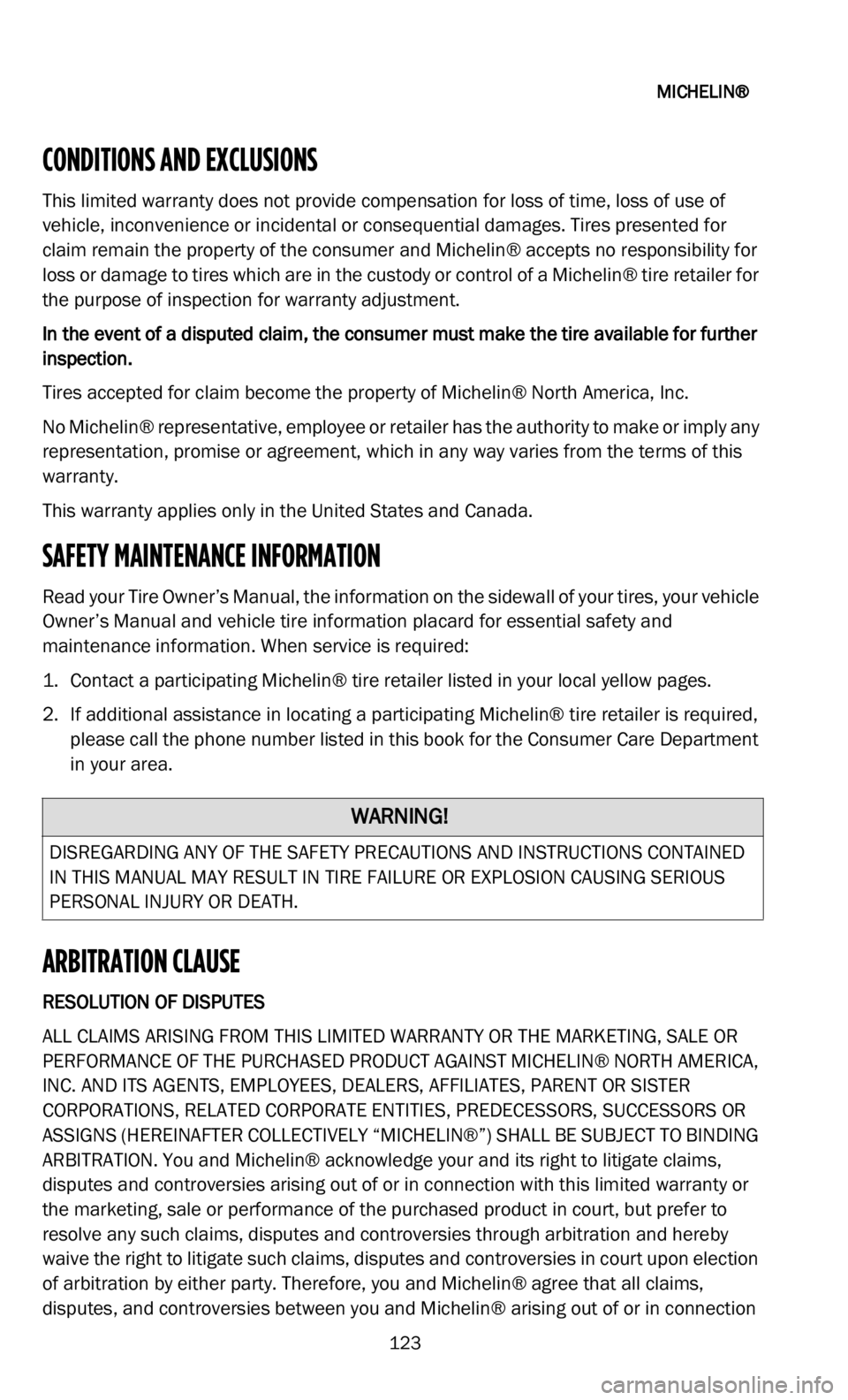ESP DODGE DURANGO 2022 Vehicle Warranty
[x] Cancel search | Manufacturer: DODGE, Model Year: 2022, Model line: DURANGO, Model: DODGE DURANGO 2022Pages: 200, PDF Size: 6.72 MB
Page 99 of 200

GOODYEAR® DUNLOP® TIRES
98
DO CHECK YOUR TIRES FOR DAMAGE
Frequent (at least monthly) inspection of your tires for signs of damage and their general
condition is important for safety. If you have any questions, have your tire dealer inspect
them. Impacts, penetrations, cracks, knots, bulges or air loss always require tire removal
and expert inspection. Never perform a temporary repair or use an inner tube as a
substitute for a proper repair. Only qualified persons should repair tires.
PROPER TIRE REPAIR
Goodyear® does not warrant any inspection or repair process. The repair is entirely the
responsibility of the repairer and should be made in accordance with established Rubber
Manufacturers Association (RMA) procedures.
Tire Pressure Monitoring System (TPMS) Alert
Refer to your vehicle Owner’s Manual for more information on what to do if the Tire
Pressure Monitoring System (TPMS) alert activates.
THE CONVENIENCE (TEMPORARY) SPARE
The Convenience (Temporary) Spare is designed, built and tested to the high engineering
standards set by North America’s leading car manufacturers and to Goodyear®’s own
high standards of quality control. It is designed to take up minimum storage space and,
at the same time, fulfill the function of a spare tire when needed. The spare is kept in its
storage space, fully inflated at 60 psi. To be sure it is always ready for use, the air
pressure should be checked on a regular basis.
The Convenience (Temporary) Spare can be used in combination with the original tires
on
your vehicle. You can expect a tire tread life of up to 3,000 miles (4,800 kilometers),
d e
pending on road conditions and your driving habits. To conserve tire tread life, return
the spare to the storage area as soon as it is convenient to have the standard tire
repaired or replaced.
The Convenience (Temporary) Spare weighs less than a standard tire so it’s easier to
h a
ndle. It also helps reduce the total car weight, which contributes to fuel economy. The
wheels used with the Convenience (Temporary) Spare are specifically designed for use
with high pressure spares and should never be used with any other type tire.
DO NOT ATTEMPT TO MOUNT YOUR OWN TIRES
Serious injury or death may result from explosion of tire/rim assembly due to improper
mounting procedures. Follow tire manufacturer’s instructions and match tire diameter to
rim diameter. Mount light truck radials on rims approved for radial service. Do not apply
bead sealer. This can inhibit bead seating. Lubricate beads and tire rim (including tube
or flap) contact surfaces. Lock assembly on mounting machine or place in safety cage.
STAND BACK and never exceed 40 psi to seat beads. Never use a volatile substance or
a rubber “donut” (also known as a bead expander or “O-Ring”) to aid bead seating. Only
specially trained persons should mount tires.
Page 102 of 200

GOODYEAR® DUNLOP® TIRES
101
TIRE SERVICE LIFE
Tires are designed and built to provide many thousands of miles/kilometers of excellent
service. For maximum benefit, tires must be maintained properly to avoid tire damage
that may result in removal from service before the tread is worn down to minimum depth.
It is not practical to accurately predict the service life of any specific tire in chronological
t i
me since service conditions vary widely. The serviceability of a tire over time is a
function of the storage and service conditions (inflation pressure, load, speed, road
hazard injury, etc.) to which a tire is subjected. Consumers should not rely solely on the
appearance of the tire, but should be aware of any change in dynamic performance such
as increased air loss, noise or vibration, which could be a sign to remove the tire.
Therefore, it is essential to have tires, including spares, inspected regularly (at least
monthly) for proper inflation pressure, damage and treadwear.
Check your vehicle’s Owner’s Manual (or your vehicle) to determine if it is equipped with
r u
n-flat (extended mobility) tires. If your vehicle is equipped with run-flat tires, the
following applies:
RUN-FLAT TECHNOLOGY EXTENDED MOBILITY TECHNOLOGY (EMT™), RUNONFLAT®
( R
OF) AND DUNLOP® SELF-SUPPORTING TECHNOLOGY (DSST®) ORIGINAL EQUIPMENT
TIRES
IMPORTANT SAFETY INFORMATION
OPERATIONAL MONITORING
The information contained in this Limited Warranty Brochure applies only to the Original
E q
uipment tires supplied with your vehicle. In order for Goodyear® Run-Flat (Extended
Mobility Technology [EMT], RunOnFlat [ROF]) or Dunlop® Run-Flat (Dunlop® Self-
Supporting Technology [DSST]) tires to obtain the performance criteria stated within this
Limited Warranty, Goodyear® or Dunlop® Run-Flat tires must use specific parts, such as
a low tire pressure monitoring system authorized by the Original Equipment vehicle
manufacturer.
RUN-FLAT TIRE FEATURE:
The Goodyear® or Dunlop® Run-Flat tire is a high-performance tire with a remarkable
f e
ature: It can operate for limited distances with very low or even no inflation pressure
(refer to your Vehicle Owner’s Manual for these limitations). This is an important benefit,
especially if inflation loss occurs at a location where immediately stopping your vehicle
could be hazardous.
TIRE PRESSURE MONITORING SYSTEM ALERT:
Refer to your vehicle Owner’s Manual for more information on what to do if the tire
p r
essure warning system activates.
Page 124 of 200

MICHELIN®
123
CONDITIONS AND EXCLUSIONS
This limited warranty does not provide compensation for loss of time, loss of use of
vehicle, inconvenience or incidental or consequential damages. Tires presented for
claim remain the property of the consumer and Michelin® accepts no responsibility for
loss or damage to tires which are in the custody or control of a Michelin® tire retailer for
the purpose of inspection for warranty adjustment.
In the event of a disputed claim, the consumer must make the tire available for further
in
spection.
Tires accepted for claim become the property of Michelin® North America, Inc.
No Michelin® representative, employee or retailer has the authority to make or imply any
re
presentation, promise or agreement, which in any way varies from the terms of this
warranty.
This warranty applies only in the United States and Canada.
SAFETY MAINTENANCE INFORMATION
Read your Tire Owner’s Manual, the information on the sidewall of your tires, your vehicle
Owner’s Manual and vehicle tire information placard for essential safety and
maintenance information. When service is required:
1. C ontact a participating Michelin® tire retailer listed in your local yellow pages.
2
. I f additional assistance in locating a participating Michelin® tire retailer is required,
p
lease call the phone number listed in this book for the Consumer Care Department
in your area.
ARBITRATION CLAUSE
RESOLUTION OF DISPUTES
ALL CLAIMS ARISING FROM THIS LIMITED WARRANTY OR THE MARKETING, SALE OR
P E
RFORMANCE OF THE PURCHASED PRODUCT AGAINST MICHELIN® NORTH AMERICA,
INC. AND ITS AGENTS, EMPLOYEES, DEALERS, AFFILIATES, PARENT OR SISTER
CORPORATIONS, RELATED CORPORATE ENTITIES, PREDECESSORS, SUCCESSORS OR
ASSIGNS (HEREINAFTER COLLECTIVELY “MICHELIN®”) SHALL BE SUBJECT TO BINDING
ARBITRATION. You and Michelin® acknowledge your and its right to litigate claims,
disputes and controversies arising out of or in connection with this limited warranty or
the marketing, sale or performance of the purchased product in court, but prefer to
resolve any such claims, disputes and controversies through arbitration and hereby
waive the right to litigate such claims, disputes and controversies in court upon election
of arbitration by either party. Therefore, you and Michelin® agree that all claims,
disputes, and controversies between you and Michelin® arising out of or in connection
WARNING!
DISREGARDING ANY OF THE SAFETY PRECAUTIONS AND INSTRUCTIONS CONTAINED
IN THIS MANUAL MAY RESULT IN TIRE FAILURE OR EXPLOSION CAUSING SERIOUS
PERSONAL INJURY OR DEATH.
Page 125 of 200

MICHELIN®
124
with this limited warranty, or any other warranties, express or implied, including a failure
of warranty, or any claims arising out of or in connection with the marketing, sale or
performance of the purchased product, including but not limited to claims for consumer
fraud or brought under any consumer protection statute, but excluding claims for
personal injury or property damage, shall be finally resolved solely by arbitration, upon
election by either party, according to the formal dispute resolution procedures then in
effect of the National Arbitration Forum, or if the National Arbitration Forum is no longer
conducting such arbitrations, a successor organization thereto or such other private
arbitration service as you and Michelin® North America, Inc. shall mutually agree (the
actual authority involved, the “Arbitral Body”). The Arbitral Body shall decide the issues
submitted in accordance herewith, provided that all substantive questions of law will be
determined under the laws of the State in which you purchased the product at issue. You
agree that no claim subject to arbitration shall be arbitrated as a class action, or on a
class-wide or representative basis, or on behalf of the general public, or on behalf of
other persons that may be similarly situated. You agree that you do not have the right to
act as a private attorney general, a class representative, or to participate as a member
of a class of claimants with any claim subject to arbitration. You further agree that no
claim subject to arbitration shall be heard by a jury and that any judgment or award of
the Arbitral Body will be final and not subject to judicial review. All arbitrations will be
conducted as document hearings. Each party shall bear its own costs arising from and
associated with the document hearing with MICHELIN® the exception of the arbitrator’s
fee which will be borne by all parties in equal shares. If either party requests any
procedures beyond a document hearing, the requesting party will be responsible for all
fees, including filing and administrative fees, above and beyond the fees required for
document hearings. Any award of the arbitrator(s) may be entered as a judgment and
shall be enforceable in any court of competent jurisdiction. The arbitrators will have no
authority to award punitive or other damages not measured by the prevailing party’s
actual damages, except as may be required by statute. Information about arbitration may
be obtained and claims may be filed at any office of the National Arbitration Forum or at
P.O. Box 50191, Minneapolis, MN 55405.
TIRE DISABLEMENT
SAFETY WARNING
Any tire may fail as a result of an improperly repaired puncture, impact damage, improper
in
flation, overloading or other conditions resulting from use or misuse. Tire failures, such
as a rapid air loss or a tread and belt detachment, may increase risk of injury or death
and/or property damage. To reduce the risk of a tire failure, Michelin® recommends you
thoroughly read and follow the recommendations in the Michelin® Owner’s Manual,
vehicle Owner’s Manual, tire placard information, and tire sidewall information regarding
safety warnings, proper tire use and maintenance.
CONTROLLABILITY
Controlling a vehicle when a tire failure occurs
If a tire failure occurs, you may hear a loud noise, feel a vibration, and/or the vehicle may
p u
ll toward the side of the failed tire. If possible, step on the accelerator momentarily to
maintain forward momentum and ensure vehicle control. It is most important that you
Page 128 of 200

MICHELIN®
127
For Example Only:
• G auge reading of hot tire:.................................................. 32 psi (220 kPa)
•
If recommended cold inflation pressure is: ..................... 30 psi (205 kPa)
•
Desired gauge reading of hot tire 30 + 4 psi =................ 34 psi (205 + 30 = 235 kPa)
•
Therefore: add 2 psi........................................................... (15 kPa)
C
heck cold pressure as soon as possible, preferably within 24 hours. “Bleeding” air from
h o
t tires could result in underinflation. Use an accurate tire gauge to check pressures.
Never allow children to inflate or deflate tires.
FOR MICHELIN® PAX® SYSTEM TIRES/SELF-SUPPORTING ZERO PRESSURE (ZP) TIRES
C H
ECK INFLATION PRESSURES AS SOON AS POSSIBLE FOLLOWING A LOW PRESSURE
WARNING
The PAX® System requires a functioning, correctly calibrated on-board vehicle tire
p r
essure monitoring system (TPMS) to monitor the air pressure and alert the driver when
a low pressure event occurs. Be certain to ensure that your vehicle’s TPMS is functioning
and is correctly calibrated. Refer to your vehicle Owner’s Manual or your vehicle dealer.
Low pressure warning systems are designed to alert the driver to a low air pressure
s i
tuation in at least one tire on the vehicle. While your ZP tires are designed to provide
continued mobility in the event of an air loss, the sooner you respond to a warning and
take corrective action, the greater the likelihood that the tire can be returned to service.
Always visually inspect your MICHELIN® PAX® System tire and self-supporting tires and
u s
e a pressure gauge to check the air pressure in all four tires following any low pressure
warning. (Unless advised to do otherwise by the manufacturer of your low pressure
warning system.)
If the tire pressure is at or below 18 PSI, proceed to the nearest Authorized PAX® System
R e
tailer for PAX® tires or a participating Michelin® tire retailer for ZP tires or a
representative of your vehicle manufacturer if advised to do so in your vehicle Owner’s
Manual and have the tire demounted and thoroughly inspected for possible internal
damage.
If you are unable to see any damage to the tire, and the tire pressure is more than
18 PSI, reinflate your tire to the proper air pressure. See instructions for checking
p r
essures when tires are hot. When tires have cooled, check air pressure again. If any
tire has lost more than 5 PSI from the previous pressure check, have the tire inspected
at once by an authorized PAX® System Retailer for PAX® tires or a participating
Michelin® tire retailer or representative of your vehicle manufacturer if your vehicle
Owner’s Manual so advises. Failure to do so may cause irreparable damage to the tire
and result in sudden tire destruction and personal injury.
TIRE PRESSURE MONITORING SYSTEMS (TPMS):
Your vehicle may be equipped with a Tire Pressure Monitoring System (TPMS) that is
designed to monitor the pressure of tires mounted on your vehicle and sends a signal to
the driver if a tire pressure falls below a predetermined level. A TPMS should not replace
monthly manual pressure checks for all four tires and the spare. We recommend that you
manually monitor and check tire pressure inflation with a pressure gauge. Your tires
Page 129 of 200

MICHELIN®
128
should have the recommended pressure listed by your vehicle’s manufacturer. This
information can be found in the vehicle Owner’s Manual and often on a placard located
in the vehicle’s door jamb, inside the fuel hatch, or on the glove compartment door. If you
have a plus size fitment that requires a higher inflation pressure, your tire pressure
monitoring system will require re-calibration to new inflation pressure. Refer to your tire
dealer/installer of plus size tires for proper inflation pressure.
We recommend checking air pressure once each month, and before a long trip. Whether
yo
u have a full-sized or mini-spare, make sure that it is properly inflated as well. If the
TPMS generates improper monitoring or signals we recommend that you consult your
Owner’s Manual provided with your vehicle and follow-up with your vehicle’s
manufacturer.
TIRE SPINNING
Do not spin wheels in excess of 35 mph (55 km/h) as indicated on the speedometer.
Ex
cessive speed in a free-running, unloaded tire can cause it to “explode” from
centrifugal force. The energy released by such an explosion is sufficient to cause serious
physical injury or death. Never allow anyone to stand near or behind the spinning tire.
When in mud, sand, snow, ice or other slippery conditions, do not engage in excessive
w h
eel spin. Accelerating the motor excessively, particularly with automatic transmission
vehicles, may cause a drive tire that has lost traction to spin beyond its speed capability.
This is also true when balancing a drive tire/wheel assembly on the vehicle using the
vehicle engine to spin the tire/wheel assembly.
HIGH SPEED DRIVING CAN BE DANGEROUS
Correct inflation pressure is especially important. However, at high speeds, even with the
correct inflation pressure, a road hazard, for example is more difficult to avoid and if
contact is made, has a greater chance of causing tire damage than at a lower speed.
Moreover, driving at high speed reduces the reaction time available to avoid accidents
and bring your vehicle to a safe stop. If you see any damage to a tire or wheel, replace it
with the spare at once and visit a participating Michelin® tire retailer.
Exceeding the maximum speeds shown on the following page for each type of Michelin®
t i
re will cause the tire to build up excessive heat which can cause tire damage that could
result in sudden tire destruction and rapid air loss. Failure to control a vehicle when one
or more tires experience a sudden air loss can lead to an accident.
In any case, you should not exceed reasonable speeds as indicated by the legal limits
a n
d driving conditions.
SPEED RATINGS
Speed Symbols are shown on the sidewall of some Michelin® tires. The following table
shows the maximum speed corresponding to the symbol.
*Some V (or VR) rated tires may have a speed capacity greater than 149 mph (240 km/h).
C o
nsult your participating Michelin® tire retailer for maximum speed rating if your vehicle
capability exceeds this speed.
Page 130 of 200

MICHELIN®
129
**Z (or ZR) rated tires are designed to use on cars with maximum speed capabilities in
excess of 149 mph (240 km/h).
(W and Y speed ratings are subcategories of Z).
Consult your Michelin® tire retailer for maximum speed capabilities. For PAX® System
Ti
res consult an authorized PAX® System Tire Retailer. Although a tire may be
speed-rated, we do not endorse the operation of any vehicle in an unsafe or unlawful
manner. Speed ratings are based on laboratory tests which relate to performance on the
road, but are not applicable if tires are underinflated, overloaded, worn out, damaged,
altered, improperly repaired or retreaded.
Furthermore, a tire’s speed rating does not imply that vehicles can be safely driven at the
m a
ximum speed for which the tire is rated, particularly under adverse road and weather
conditions or if the vehicle has unusual characteristics.
Michelin® highway passenger tires that do not have a speed symbol on the sidewall have
a
maximum speed rating of 105 mph (170 km/h). Light truck highway tires that do not
h a
ve a speed symbol on the sidewall of the tire have a maximum speed rating of 87 mph
( 1
40 km/h).
Michelin® Winter tires that do not have a speed symbol on the sidewall or tires with Q
s y
mbols have a speed rating of 100 mph (160 km/h). Winter tires with a speed symbol
h a
ve a maximum speed rating in accordance with the symbol.
The speed and other ratings of retreaded tires are assigned by the retreader and replace
t h
e original manufacturer’s ratings.
IMPORTANT: In order to maintain the speed capability of the vehicle, replacement tires
m u
st have speed ratings equal to or higher than those fitted as original equipment (as
indicated on the vehicle tire placard or Owner’s Manual). If tires with lower speed ratings
are fitted, the vehicle’s handling may be affected and the speed capability of the vehicle
will be lowered to the maximum speed capability of the replacement tires as indicated in
the following table.
REMEMBER H
igh speed driving can be dangerous and may damage your tires.
AND When driving at highway speeds, correct inflation pressure is especially important.
S
PEED Ratings Maximum Speed
Km/h mph
M 13081
N 14087
P 15093
Q 160100
R 170106
S 180112
T 190118
Page 133 of 200

MICHELIN®
132
TIRE MIXING
Michelin® tires are radial tires and for best performance it is recommended that the
same size and type of tire be used on all four wheel positions. Before mixing tires of
different types in any configuration on any vehicle, be sure to check the vehicle
manufacturer’s owner‘s manual for its recommendations.
It is especially important to check the vehicle manufacturer’s Owner’s Manual when
mi
xing, matching, or replacing tires on 4-wheel drive vehicles, as this may require special
precautions.
MICHELIN® DOES NOT RECOMMEND MIXING PAX® SYSTEM TIRES WITH NON-PAX®
T I
RES/SELF-SUPPORTING ZERO PRESSURE (ZP) TIRES WITH NON-ZP TIRES OTHER THAN
THE TEMPORARY USE OF THE SPARE IF THE VEHICLE IS SO EQUIPPED.
WINTER DRIVING
Tires which meet the US Tire Manufacturers Association (USMTA) definition of snow tires
are marked M/S, or M&S. On such tires, this designation is molded into the sidewall.
Tires without this notation are not recommended or Winter driving.
While All-Season tires are designed to provide reliable performance in some
Winter conditions, the use of four Winter tires is recommended for optimal
p e
rformance. Tires designate for use in severe Winter conditions are marked
on at least one sidewall with the letter “M”.
TIRE ROTATION AND REPLACEMENT
To obtain maximum tire wear, it may be necessary to rotate your tires. Refer to your
vehicle owner’s manual for instructions on tire rotation. If you do not have an owner‘s
manual for your vehicle, Michelin® recommends rotating your tires every 6,000 to
8,000 miles (10,000 to 12,000 km).
Monthly inspection for tire wear is recommended. Your tires should be rotated at the first
s i
gn of irregular wear, even if it occurs before 6,000 miles (10,000 km). This is true for
a l
l vehicles.
When rotating tires with a directional tread pattern, observe the arrows molded on the
s i
dewall which show the direction the tire should turn. Care must be taken to maintain
the proper turning direction.
Some Tire Pressure Monitoring Systems (TPMS) may not recognize that a tire has been
m o
ved to a different position on your vehicle. Make certain that your TPMS system is
reset, if necessary, so as to correctly identify the location of each tire on your vehicle.
Refer to your vehicle owner’s manual or your vehicle dealer.
Determine whether rotated tires require tire inflation adjustment as front and rear
p o
sition tire pressure may vary according to the vehicle manufacturer’s specification due
to the actual load on that wheel position. Some vehicles may have different sized tires
mounted on the front and rear axles, and these different sized tires have rotation
restrictions. Always check the vehicle owner’s manual for the proper rotation
recommendations.
Page 142 of 200

NEXEN TIRE
141
MILEAGE TREAD WEAR LIMITED WARRANTY
Most patterns manufactured by Nexen Tire are assigned a mileage warranty that
protects the consumer against premature tread wear. If a tire reaches the end of its
“usable tread life” before the stated mileage warranty, the consumer will be issued a
replacement Nexen Tire on a pro rata basis, which means the consumer will be
responsible for a percentage of the replacement cost. In order to maintain tread wear
warranty, all tires must be rotated at least every 5,000-6,000 miles (8,000-10,000 km).
U n
der all circumstances, the cost of mounting, balancing and any other service charges
including applicable taxes are required to be paid by the consumer.
WHAT IS NOT COVERED UNDER THIS LIMITED WARRANTY
• Ride complaints after the first 2/32 of an inch of tread wear or replacement of three or more tires from the same vehicle will not be accepted.
• R oad hazard damage such as cuts, snags, punctures or tire repair, bruises, impact
b
reaks, etc. Check Road Hazard Replacement Program for patterns that are covered
against this type of damage.
• P remature or irregular wear due to vehicle mechanical deficiencies or failure to rotate
t
he tires at recommended intervals.
• T ires on any vehicle registered and normally operated outside the United States.
•
Damage from incorrect mounting or dismounting of the tire, incorrect application,
w
ater or other material trapped inside the tire during mounting or failure to balance
the tires.
• D amage from overinflation or underinflation, overloading, fire, theft, and defective
v
ehicle mechanical conditions.
• R acing, off road use and misapplications of tire to vehicle.
•
Ozone or weather cracking on tires after 48
months from the date of manufacture or
ot
her abuse, misuse, tire alteration, run flat.
• A ny tires worn beyond the wear indicators. Less than 2/32 of an inch remaining tread
d
epth.
• F lat spotting caused by improper storage or brake lock.
•
Accident, fire, chemical corrosion, tire alteration or vandalism.
•
Tire which DOT identification number and/or brand name removed intentionally.
•
Loss of time or use, inconvenience or any incidental or consequential damage.
•
Original equipment tires on new vehicle. See separate warranty, if applicable, in your
v
ehicle’s glove box.
• T ires purchased as used.
•
Tires used on Recreational Vehicles (For camping & Motor homes, etc.) or in commer -
c
ial service.
Page 143 of 200

NEXEN TIRE 142
OTHER LIMITATIONS INCLUDE BUT ARE NOT LIMITED TO THE FOLLOWING:
• Failure to rotate tires as recommended voids the tread wear warranty.
• If tires are different size on front and rear of vehicle, and therefore can’t be rotated,
t
he mileage warranty for the rear tires will be half of the stated mileage warranty.
• W inter tires must be used only in winter months, which are determined to be
S
eptember 1st through April 30th of the following year. Documentation is required
showing date of installation and removal to maintain tread wear warranty.
ROAD HAZARD REPLACEMENT PROGRAM
Most patterns sold by Nexen Tire are covered by a road hazard warranty that protects the
consumer against non-repairable damage caused by puncture, snag, cut, bruise or
impact break. Typical road hazards are nails, glass, potholes and other debris. Covered
tires will be eligible for a free replacement for the first 3/32 of an inch of original tread
depth, or for a period of two years from the date of purchase; whichever comes first. If
the DOT number on the tire is greater than two years from the adjustment date, an
invoice showing date of purchase is necessary. The cost of mounting, balancing and any
other service charges including applicable taxes are required to be paid by the consumer.
WHAT IS NOT COVERED UNDER THE ROAD HAZARD REPLACEMENT PROGRAM
• A tire that is damaged due to vandalism.
• A tire that is damaged due to an accident.
•
A tire that is repairable under Rubber Manufacturers Association (RMA) standards.
•
A tire that has failed due to commercial use.
•
A tire that is damaged or failed due to racing or off road use.
•
A tire that is damaged due to use of snow chains or studs.
•
A tire that is damaged or failed due to irregular wear caused by mechanical issues.
•
Original equipment tires on new vehicle.
•
Tires transferred from the vehicle that they were originally installed.
CONSUMER’S OBLIGATION WHEN FILING CLAIM
To maintain Mileage Tread Wear Warranty and Road Hazard Replacement Program, the
consumer is responsible for the following:
• A ny claims must be presented to an authorized Nexen Tire dealer.
•
Submit or present a copy of the original purchase receipt with documented automobile
m
ileage at time of tire installation and of tire dismounting.
• S ubmit a tire rotation record showing that all tires have been rotated at least every
5
,000-6,000 miles (8,000-10,000 km). Tire rotation record is not necessary for
M i
leage claims when tire is within 2/32 of an inch difference of remaining tread depth